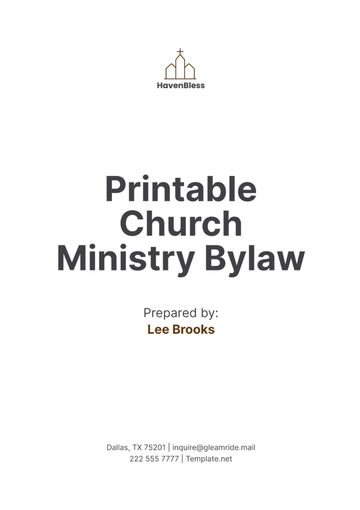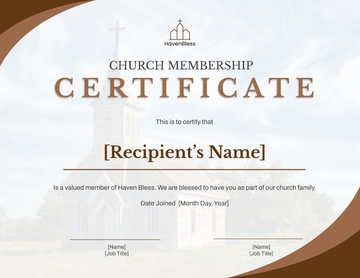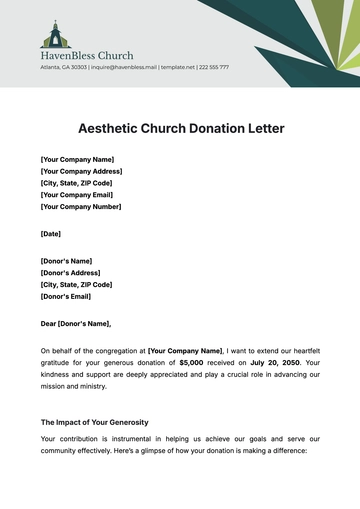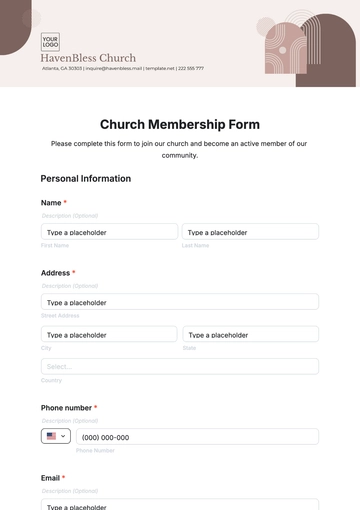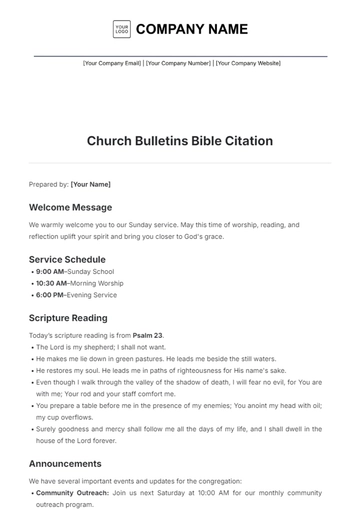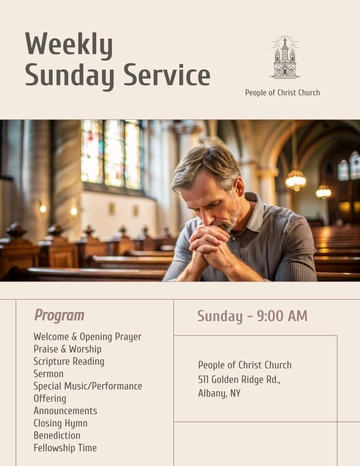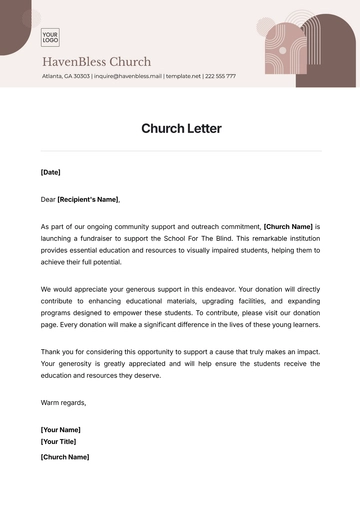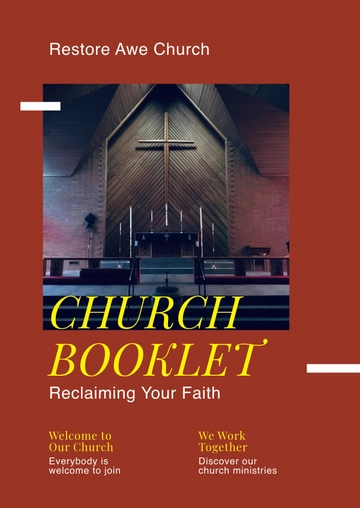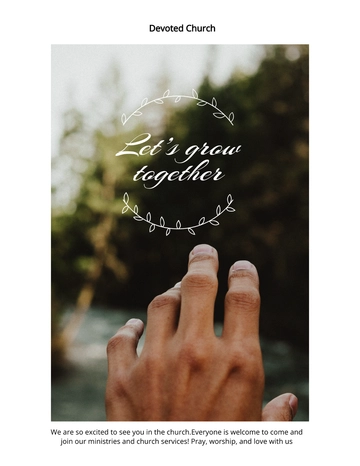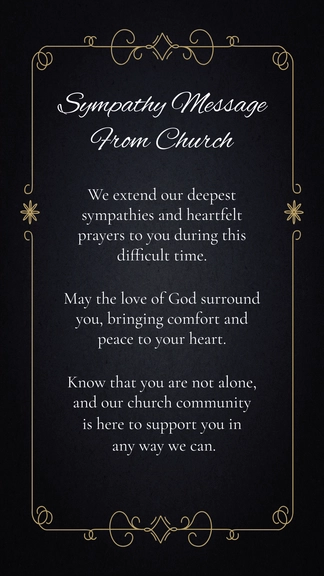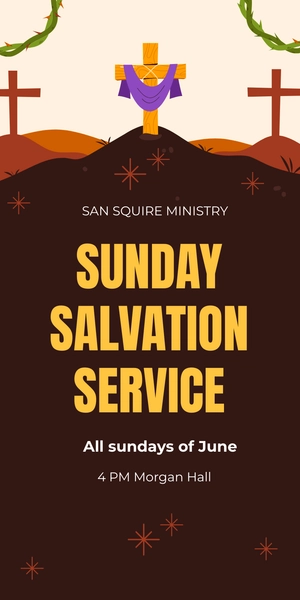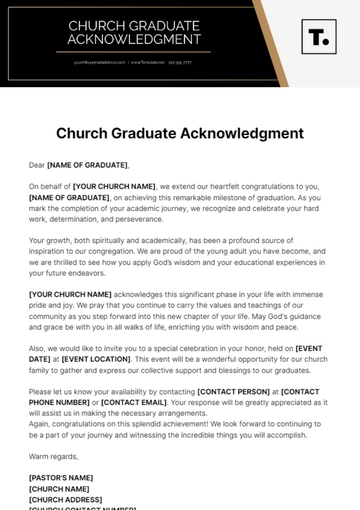Free Church Fundraising Guide

I. Introduction
A. Purpose of the Guide
The purpose of this guide is to provide churches with a comprehensive resource for planning, organizing, and executing effective fundraising campaigns. Fundraising is a crucial aspect of maintaining and expanding church activities, supporting various community programs, and managing operational costs. This guide is designed to offer a structured approach to fundraising, with step-by-step instructions, practical advice, and real-world examples to help church leaders and volunteers achieve their financial goals. By following the strategies outlined here, churches can build robust fundraising campaigns that resonate with their congregations and communities.
B. Importance of Fundraising for Churches
Fundraising is not just a means to gather money; it is a vital component of a church's ability to fulfill its mission and sustain its programs. It supports a wide range of activities, from maintaining and upgrading church facilities to funding community outreach programs and supporting staff salaries. Effective fundraising helps ensure that a church can continue to provide spiritual guidance, community support, and social services. Additionally, a well-executed fundraising campaign can strengthen community bonds, increase member engagement, and enhance the church's visibility and impact within the community.
C. Overview of Fundraising Strategies
This guide will explore a variety of fundraising strategies, from traditional methods to modern digital approaches and innovative ideas. Traditional methods such as pledge drives, events, and direct mail campaigns are still effective, but incorporating digital techniques like online donation platforms and crowdfunding can significantly expand your reach. We will also discuss creative fundraising ideas that can set your campaign apart and engage your congregation in new ways. Each strategy will be detailed with practical tips, examples, and step-by-step instructions to help you implement them successfully.
II. Planning Your Fundraising Campaign
A. Setting Clear Goals
1. Define Your Objectives
Start by defining clear and specific objectives for your fundraising campaign. Objectives could range from raising funds for a new church building, renovating existing facilities, or supporting a special outreach program. Be specific about what you want to achieve and why it is important. For example, if your objective is to raise $50,000 for a new roof, detail how this investment will improve the church's facilities and benefit the congregation. Clear objectives provide direction and motivation, making it easier to communicate your goals to potential donors.
2. Establish a Fundraising Target
Once you have defined your objectives, set a realistic fundraising target. Consider factors such as the size of your congregation, previous fundraising results, and current economic conditions. Break down your target into smaller, manageable milestones to make it easier to track progress. For instance, if you aim to raise $50,000, set interim goals of $10,000 each month to keep the momentum going. Setting a clear target helps focus efforts, allocate resources effectively, and measure success.
3. Create a Timeline
Develop a detailed timeline for your fundraising campaign. Outline key dates for planning, promotion, events, and follow-up activities. A well-structured timeline ensures that each phase of the campaign is completed on schedule and helps avoid last-minute rushes. Include important milestones such as the launch date, key events, and deadlines for promotional materials. A timeline also allows for adjustments if needed, ensuring that your campaign stays on track and achieves its objectives.
B. Assembling a Fundraising Team
1. Identify Key Roles
Successful fundraising requires a team with diverse skills and responsibilities. Key roles may include a campaign chairperson to oversee the overall strategy, an event coordinator to manage logistics, a marketing specialist to handle promotions, and a financial manager to track donations and expenses. Clearly define each role's responsibilities to ensure that all aspects of the campaign are covered. For example, the event coordinator might be responsible for securing venues and managing event logistics, while the marketing specialist handles social media and print advertising.
2. Recruit Volunteers
Engage church members by recruiting volunteers to join the fundraising team. Look for individuals who are passionate about the church's mission, possess strong organizational skills, and are willing to dedicate time and effort. Promote volunteer opportunities during church services, in newsletters, and on social media to attract a diverse group of supporters. Engaging volunteers not only spreads the workload but also fosters a sense of ownership and community involvement in the fundraising effort.
3. Provide Training and Resources
Equip your fundraising team with the necessary training and resources to perform their roles effectively. Offer workshops on fundraising techniques, provide access to relevant software and tools, and share educational materials on donor engagement. Training helps volunteers understand their responsibilities, improve their skills, and contribute more effectively to the campaign. Providing resources such as templates for promotional materials or guides on using fundraising software ensures that the team has the tools they need to succeed.
C. Budgeting for the Campaign
1. Estimate Costs
Prepare a comprehensive budget that outlines all anticipated expenses for the campaign. Include costs for promotional materials, event venues, refreshments, technology, and any other relevant items. For instance, if you're hosting a fundraising gala, budget for venue rental, catering, entertainment, and decorations. Accurate cost estimates help in managing finances and avoiding unexpected expenses. Include a contingency fund to cover any unforeseen costs that may arise during the campaign.
2. Allocate Funds Wisely
Distribute your budget in a way that maximizes the impact of your fundraising efforts. Prioritize high-return activities and ensure that essential expenses are covered. For example, investing in high-quality promotional materials can enhance your campaign's visibility and effectiveness. Allocate funds to areas that will generate the most significant return on investment, such as marketing and event promotion, while being mindful of cost-effective options for other expenses.
3. Monitor and Adjust
Regularly review and monitor your budget throughout the campaign. Track actual expenses against your estimates and make adjustments as necessary. Effective budget management helps prevent overspending and ensures that funds are used efficiently. For example, if you find that your event costs are exceeding estimates, look for ways to reduce expenses or seek additional sponsorship to cover the shortfall. Monitoring your budget allows for timely adjustments and helps keep the campaign on track financially.
III. Fundraising Strategies
A. Traditional Fundraising Methods
1. Pledge Drives
Pledge drives involve asking church members to commit to donating a specific amount over a designated period. This method helps create a predictable cash flow and encourages sustained giving. Organize a pledge Sunday where members can fill out pledge cards and make their commitments. Provide clear information on how the pledged funds will be used and the impact they will have. For example, if you're raising funds for a new church building, explain how each pledge will contribute to the project's success.
2. Events
Hosting fundraising events such as dinners, auctions, or concerts can engage your congregation and raise significant funds. Plan events that cater to different demographics within your church. For instance, a family fun day with games and activities might attract young families, while a formal gala dinner could appeal to older members. Promote your events through multiple channels, including social media, church bulletins, and local media, to maximize attendance and participation.
3. Direct Mail Campaigns
Direct mail remains an effective way to reach potential donors with personalized appeals. Send letters detailing your fundraising goals, the impact of their contributions, and instructions on how to donate. Include a pre-addressed return envelope to make the giving process easy. Personalize your letters to address the recipient by name and highlight their past support if applicable. Direct mail campaigns can be particularly effective when combined with follow-up phone calls or emails to reinforce the message.
B. Digital Fundraising Techniques
1. Online Donation Platforms
Utilize online donation platforms to make giving convenient for your supporters. Platforms like [Your Company Name] Donations provide secure and user-friendly interfaces for one-time or recurring donations. Promote these platforms through your church’s website, social media, and email newsletters. Ensure that the donation process is simple and straightforward, with options for different giving levels and payment methods. Highlight the ease of online giving to encourage more people to contribute.
2. Crowdfunding Campaigns
Crowdfunding allows you to leverage the power of social networks to reach a broader audience. Create a compelling campaign on platforms like GoFundMe or Kickstarter, and encourage church members to share the campaign with their friends and family. Craft a persuasive campaign story that highlights the need for funds and the impact on your church’s mission. Use visuals, such as photos and videos, to capture attention and drive engagement. Offer updates throughout the campaign to keep supporters informed and motivated.
3. Social Media Fundraising
Harness the power of social media to promote your fundraising efforts and engage with your audience. Use platforms such as Facebook, Twitter, Instagram, and LinkedIn to share updates, success stories, and calls to action. Create engaging content, including videos, infographics, and testimonials, to capture attention and encourage sharing. Run targeted ads to reach potential donors outside your immediate congregation. Social media fundraising can expand your reach and increase visibility for your campaign.
C. Innovative Fundraising Ideas
1. Peer-to-Peer Fundraising
Peer-to-peer fundraising empowers your supporters to raise money on your behalf by creating personal fundraising pages. Provide them with the tools and resources needed to set up their pages, share their stories, and solicit donations from their networks. This approach can significantly broaden your donor base and increase fundraising potential. Offer guidance and support to your fundraisers to help them succeed. Recognize and reward top fundraisers to motivate others to participate.
2. Text-to-Give
Text-to-give is a convenient way for donors to contribute using their mobile phones. Set up a dedicated phone number that supporters can text to make a donation. Promote this option during services, events, and through your communication channels. Ensure that the process is simple and secure, with clear instructions for donors. Text-to-give can be particularly effective for spontaneous donations and can be easily integrated into other fundraising activities.
3. Legacy Giving
Encourage members to include your church in their estate plans or wills. Legacy giving, also known as planned giving, allows donors to make a significant contribution through their estates. Provide information on how to make a legacy gift and offer guidance on the different options available, such as bequests, charitable trusts, or gifts of securities. Highlight the impact that legacy gifts can have on the church’s long-term sustainability and future projects.
IV. Implementing Your Campaign
A. Promoting Your Campaign
1. Creating Marketing Materials
Develop a range of marketing materials to promote your fundraising campaign. This includes flyers, posters, brochures, and digital content. Ensure that your materials are visually appealing and convey your message clearly. Include key information such as your fundraising goals, how donations will be used, and how people can contribute. Use high-quality images and compelling language to capture attention and generate interest.
2. Leveraging Social Media
Utilize social media platforms to reach a wide audience and engage with potential donors. Create a content calendar to plan your posts and ensure consistent communication throughout the campaign. Share updates, success stories, and testimonials to keep your audience informed and motivated. Encourage members to share your posts and spread the word within their networks. Social media can be a powerful tool for building momentum and attracting new supporters.
3. Engaging Local Media
Reach out to local newspapers, radio stations, and TV channels to gain coverage for your fundraising campaign. Craft press releases and pitch your story to local media outlets. Highlight the significance of your campaign, its impact on the community, and any upcoming events. Media coverage can increase visibility and attract attention from potential donors who may not be reached through other channels.
B. Managing Fundraising Events
1. Event Planning
Thoroughly plan each fundraising event to ensure its success. This includes selecting a venue, organizing logistics, and coordinating with vendors. Create a detailed event timeline, including setup, the event schedule, and teardown. Assign tasks to team members and ensure that everyone is clear on their responsibilities. For example, if you’re hosting a charity auction, coordinate with donors to secure items, set up bidding stations, and plan entertainment and refreshments.
2. Volunteer Coordination
Effectively manage volunteers to ensure smooth operation during events. Provide clear instructions and training on their roles and responsibilities. Assign specific tasks, such as registration, setup, or overseeing activities, and ensure that volunteers have the resources they need. Regularly communicate with your volunteers to address any questions or concerns and keep them informed about the event's progress.
3. Post-Event Follow-Up
After the event, follow up with attendees and donors to express gratitude and provide updates on the campaign’s success. Send thank-you notes, emails, or phone calls to acknowledge their support and share how their contributions are making a difference. Gather feedback from attendees and volunteers to evaluate the event’s success and identify areas for improvement. Post-event follow-up helps maintain positive relationships and encourages continued support.
C. Handling Donations
1. Donation Processing
Efficiently process donations to ensure accurate tracking and acknowledgment. Use donation management software to record contributions and generate receipts. Provide clear instructions for how donations can be made, whether online, by check, or in person. Ensure that all donations are processed promptly and accurately to maintain transparency and build trust with your supporters.
2. Acknowledging Contributions
Timely and personalized acknowledgment of contributions is essential for maintaining donor relationships. Send thank-you letters or emails to express appreciation and provide information on how their donation will be used. Include details such as the amount donated, the campaign’s progress, and the impact of their support. Personalized acknowledgments reinforce the importance of each donor’s contribution and encourage continued giving.
3. Reporting and Transparency
Maintain transparency by regularly reporting on the fundraising campaign’s progress and financial status. Provide updates on the total amount raised, how funds are being used, and any significant milestones achieved. Publish detailed financial reports that outline income and expenses, and make them available to donors and the congregation. Transparency fosters trust and demonstrates accountability in managing donations.
V. Maintaining Donor Relationships
A. Communication and Engagement
1. Regular Updates
Keep your congregation and donors informed about the progress of your fundraising campaign. Share updates on milestones achieved, total funds raised, and how the money is being utilized. Regular communication helps build trust and keeps supporters engaged. Use various channels, such as newsletters, social media, and your church’s website, to provide updates and maintain interest in the campaign.
2. Publishing Financial Reports
Publish detailed financial reports that outline how the funds were raised and spent. Include information on specific projects funded, administrative costs, and any remaining balances. Transparency in financial reporting builds credibility and reassures donors that their contributions are being used effectively. Make reports accessible on your church’s website and provide printed copies for those who prefer hard copies.
3. Holding Accountability Meetings
Schedule periodic accountability meetings where church leaders can discuss the status of the fundraising campaign and address questions from the congregation. These meetings provide an opportunity for open dialogue, address any concerns, and highlight the campaign’s achievements. Accountability meetings foster a culture of openness and ensure that everyone feels included and informed about the campaign’s progress.
B. Post-Campaign Activities
1. Evaluating the Campaign
Conduct a thorough evaluation of the fundraising campaign to understand what worked well and identify areas for improvement. Analyze the results by comparing the total funds raised against your initial targets and assessing the effectiveness of different fundraising methods. Review feedback from donors, volunteers, and team members to gain insights into their experiences. This evaluation helps refine future campaigns and improve overall fundraising strategies.
2. Gathering Feedback
Collect feedback from donors, volunteers, and church members to gain insights into their experiences with the fundraising campaign. Use surveys, interviews, and focus groups to gather constructive feedback. Ask questions about what they liked, what could be improved, and any suggestions for future campaigns. Feedback is invaluable for making informed decisions and enhancing future fundraising efforts.
3. Documenting Lessons Learned
Document the lessons learned from your fundraising campaign in a detailed report. Highlight successful strategies, challenges faced, and areas for improvement. Include specific examples of what worked well and any adjustments made during the campaign. This report serves as a valuable reference for planning future campaigns and helps build on past successes.
C. Celebrating Success
1. Hosting a Celebration Event
Celebrate the success of your fundraising campaign with your congregation by hosting a special event. This could be a thank-you dinner, a recognition ceremony, or a community gathering. Use the event to share the achievements, express gratitude to supporters, and highlight the impact of the funds raised. Celebrating success reinforces positive outcomes and strengthens community bonds.
2. Sharing Success Stories
Share stories of how the funds raised have made a difference in the community. Highlight specific projects, individuals, or programs that benefited from the campaign. Use newsletters, social media, and church services to share these success stories. Personalizing the impact of donations helps donors see the tangible results of their contributions and reinforces their commitment to supporting the church.
3. Recognizing Contributions
Publicly recognize the contributions of key volunteers, donors, and supporters. Offer awards, certificates, or small tokens of appreciation to acknowledge their efforts and support. Recognizing contributions helps build a positive and supportive environment, encourages continued involvement, and demonstrates your appreciation for their commitment to the church’s mission.
VI. Continuous Fundraising
A. Developing a Long-Term Fundraising Strategy
1. Setting Ongoing Goals
Establish long-term fundraising goals that align with your church’s mission and vision. These goals should address ongoing needs such as facility maintenance, program funding, and community outreach. For example, set a goal to raise $100,000 annually for community outreach programs. Long-term goals provide direction and help in planning sustained fundraising efforts. Clearly define these goals and create a strategic plan to achieve them.
2. Planning Regular Fundraising Activities
Incorporate regular fundraising activities into your church calendar to maintain a steady flow of donations. Plan annual events, pledge drives, and campaigns to keep your congregation engaged. Ensure that these activities are well-spaced throughout the year to avoid overlap and maintain momentum. Regular fundraising activities help sustain financial support and build a culture of giving within your church community.
3. Building a Fundraising Calendar
Develop a comprehensive fundraising calendar that outlines key events, campaigns, and activities throughout the year. This calendar helps in organizing and coordinating efforts, ensuring that all fundraising activities are planned and executed effectively. Include important dates such as event deadlines, promotion periods, and follow-up activities. A well-organized calendar ensures that your fundraising efforts are structured and aligned with your overall strategy.
B. Engaging Donors Year-Round
1. Maintaining Regular Communication
Keep in touch with your donors throughout the year to maintain their engagement and support. Send regular updates on church activities, upcoming events, and the impact of their contributions. Use newsletters, social media, and personalized communications to keep donors informed and involved. Regular communication helps build strong relationships with donors and keeps them connected to your church’s mission.
2. Offering Recurring Giving Options
Encourage donors to set up recurring donations to provide a steady income stream. Offer options for monthly or quarterly giving to make it easier for donors to contribute on a regular basis. Promote these options through your website, communication channels, and during events. Recurring giving provides financial stability and allows donors to support your church’s mission consistently over time.
3. Creating a Donor Recognition Program
Develop a donor recognition program to acknowledge and reward ongoing support. This program can include special events, exclusive updates, and personalized thank-you messages. Offer recognition for different levels of giving and provide meaningful tokens of appreciation. A well-designed recognition program helps build loyalty, encourages continued support, and fosters a positive relationship with your donors.
C. Expanding Your Donor Base
1. Reaching Out to the Wider Community
Expand your fundraising efforts beyond the church congregation to reach a broader audience. Engage with local businesses, community organizations, and individuals who share your values and interests. Use outreach strategies such as partnerships, sponsorships, and community events to attract new supporters. Building relationships with the wider community can open up new funding opportunities and enhance your fundraising efforts.
2. Leveraging Technology and Innovation
Embrace new technologies and innovations to enhance your fundraising capabilities. Explore emerging trends such as virtual events, mobile giving, and online engagement tools. Stay updated on the latest fundraising technologies and adapt your strategies to incorporate these advancements. Leveraging technology helps reach a wider audience, streamline processes, and improve overall fundraising efficiency.
3. Building Strategic Partnerships
Develop strategic partnerships with other organizations and businesses to support your fundraising efforts. Collaborate on joint events, sponsorships, and promotional activities to leverage each other’s networks and resources. Strategic partnerships can provide additional funding, increase visibility, and enhance your overall fundraising impact. Identify potential partners whose mission aligns with your own and build mutually beneficial relationships.
VII. Evaluating and Enhancing Fundraising Efforts
A. Assessing Campaign Effectiveness
1. Analyzing Data and Metrics
To evaluate the effectiveness of your fundraising campaign, analyze relevant data and metrics. Track key performance indicators such as total funds raised, donor participation rates, and average donation amounts. Utilize analytics tools to measure the success of different fundraising channels and strategies. For instance, if you implemented both online and direct mail campaigns, compare their performance to determine which was more effective. Detailed data analysis helps identify successful elements and areas needing improvement.
2. Reviewing Donor Feedback
Collect and review feedback from donors to gain insights into their experiences and perceptions of your campaign. Use surveys, interviews, or focus groups to gather opinions on various aspects such as communication, ease of donation, and overall satisfaction. For example, if donors indicate that the donation process was cumbersome, consider simplifying it in future campaigns. Understanding donor feedback helps tailor your approach and improve future fundraising efforts.
3. Measuring Impact and Outcomes
Assess the impact and outcomes of your fundraising campaign to understand its effectiveness in achieving your goals. Measure how the raised funds were utilized and evaluate the tangible benefits provided to your church or community. For example, if funds were raised for a new community center, assess the center’s usage and the benefits to the community. Document these outcomes and use them to demonstrate the success of your campaign to stakeholders and supporters.
B. Implementing Improvements
1. Identifying Areas for Improvement
Based on your evaluation, identify specific areas where improvements can be made. This could include refining fundraising strategies, enhancing communication, or improving donor engagement. For instance, if certain fundraising events did not meet expectations, analyze the reasons and adjust future planning accordingly. Identifying areas for improvement helps in refining your approach and increasing the effectiveness of future campaigns.
2. Updating Fundraising Strategies
Revise and update your fundraising strategies based on the insights gained from your evaluation. Implement new techniques, adjust existing methods, and explore innovative approaches to enhance your fundraising efforts. For example, if online giving proved successful, consider expanding digital campaigns or integrating new technology. Regularly updating your strategies ensures that your fundraising efforts remain relevant and effective.
3. Training and Development
Provide ongoing training and development opportunities for your fundraising team to enhance their skills and knowledge. Offer workshops, seminars, or online courses on topics such as donor relations, digital marketing, and event management. Investing in professional development helps your team stay current with best practices and improves their ability to execute successful fundraising campaigns.
C. Building a Culture of Giving
1. Fostering a Donor-Centric Approach
Create a donor-centric culture that prioritizes the needs and preferences of your supporters. Tailor your communication and engagement strategies to focus on what matters most to your donors. For example, segment your donor list and personalize your outreach based on their giving history and interests. A donor-centric approach helps build stronger relationships and encourages long-term support.
2. Promoting Volunteerism
Encourage and promote volunteerism within your church community. Recognize and appreciate the efforts of volunteers who contribute their time and skills to support fundraising activities. Offer a range of volunteer opportunities to accommodate different interests and availability. Promoting volunteerism helps build a sense of community and shared responsibility, enhancing overall support for your fundraising initiatives.
3. Celebrating and Sharing Successes
Celebrate and share the successes of your fundraising campaigns to build momentum and inspire continued support. Publicize achievements through newsletters, social media, and church services. Recognize the contributions of donors, volunteers, and team members to show appreciation and reinforce their commitment. Sharing success stories and celebrating milestones fosters a positive environment and encourages ongoing engagement.
VIII. Case Studies and Examples
A. Successful Fundraising Campaigns
1. Case Study: Community Center Renovation
In a successful campaign to renovate a community center, the church set a target of $100,000. They organized a series of events, including a fundraising gala, a community fun run, and a silent auction. The campaign utilized online donation platforms and social media to reach a broader audience. By combining these efforts with targeted direct mail campaigns, they exceeded their goal, raising $120,000. The renovated community center now hosts various programs and events, benefiting the entire community.
2. Case Study: Annual Pledge Drive
A church implemented an annual pledge drive to support its ongoing operational costs. They set a goal of $75,000 and engaged members through personal appeals and church-wide events. The campaign featured a pledge Sunday, where members made commitments for the year, and followed up with regular reminders and updates. The campaign raised $80,000, allowing the church to fund its programs and maintain its facilities. The success of the pledge drive demonstrated the effectiveness of sustained engagement and clear communication.
3. Case Study: Digital Crowdfunding Campaign
A church launched a digital crowdfunding campaign to fund a new youth outreach program. They created a compelling campaign page on GoFundMe, shared it on social media, and engaged local influencers to promote it. The campaign featured video testimonials from program participants and detailed information on the program’s impact. With a target of $30,000, the campaign raised $35,000 through a combination of online donations and social media shares. The success of this campaign highlighted the power of digital tools and community engagement.
B. Lessons Learned from Fundraising Efforts
1. Importance of Clear Communication
Clear and consistent communication is crucial for successful fundraising campaigns. Effective communication helps convey your message, engage supporters, and manage expectations. Ensure that all promotional materials, updates, and appeals are clear, concise, and aligned with your campaign’s objectives. For example, avoid jargon or technical language that might confuse potential donors.
2. Engaging and Motivating Volunteers
Volunteers are vital to the success of fundraising campaigns. Engaging and motivating volunteers through recognition, training, and support enhances their effectiveness and dedication. Regularly acknowledge their contributions and provide opportunities for feedback. For instance, recognize top volunteers with awards or public acknowledgments to maintain their enthusiasm and commitment.
3. Adapting to Feedback
Being open to feedback and willing to adapt is essential for improving your fundraising efforts. Regularly seek input from donors, volunteers, and team members to identify areas for enhancement. Use this feedback to make informed decisions and refine your strategies. For example, if donors express a preference for online giving, consider expanding your digital fundraising options.
IX. Conclusion
A. Recap of Key Points
This Church Fundraising Guide provides a comprehensive framework for planning, executing, and evaluating successful fundraising campaigns. Key points include setting clear goals, assembling a dedicated team, budgeting effectively, and utilizing a range of traditional and digital fundraising strategies. The guide also emphasizes the importance of continuous improvement, donor engagement, and celebrating successes.
B. Final Thoughts
Effective fundraising is an ongoing process that requires careful planning, execution, and evaluation. By following the strategies outlined in this guide, churches can build robust fundraising campaigns that support their missions and enhance their community impact. Remember to adapt your approach based on feedback and evolving needs, and celebrate the successes achieved along the way.
C. Encouragement for Future Campaigns
As you embark on your fundraising journey, stay focused on your church’s mission and the positive impact you aim to achieve. Be innovative, engage your community, and continually refine your strategies to maximize your success. Each campaign is an opportunity to strengthen your church’s presence, support its programs, and foster a culture of giving. With dedication and perseverance, your fundraising efforts can make a significant difference in achieving your church’s goals and supporting its mission.
- 100% Customizable, free editor
- Access 1 Million+ Templates, photo’s & graphics
- Download or share as a template
- Click and replace photos, graphics, text, backgrounds
- Resize, crop, AI write & more
- Access advanced editor
Boost fundraising efforts with the Church Fundraising Guide Template on Template.net. This editable tool ensures clear strategies and goals. Use our Ai Editor Tool to draft comprehensive guides, outlining campaign plans, donor engagement, and financial targets, optimizing your church’s fundraising initiatives.
